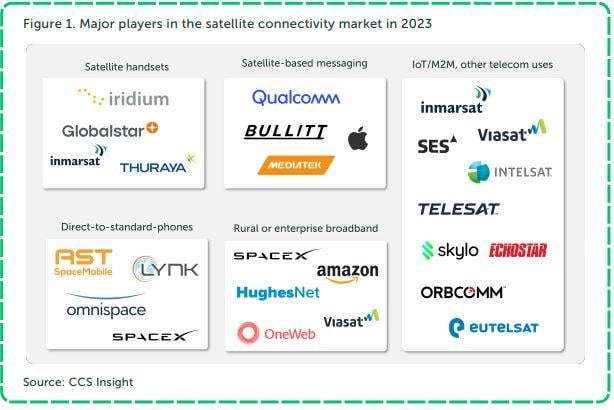If you’re having trouble keeping score in the ever-changing satellite phone space, have no fear. CCS Insight put together a report on the state of the market and where it’s headed.
Suffice it to say the direct-to-satellite market is comprised of a multitude of satellite operators and service providers. In one of the charts accompanying the new report, CCS lists 20 different major 2023 market players, including Amazon, AST SpaceMobile, Bullitt, Globalstar, Inmarsat, Intelsat, Iridium, Lynk, Mediatek, OneWeb, SES, SpaceX and Viasat. Also on the list: Thurava, Omnispace, HughesNet, Skylo, Echostar, Orbcomm and Eutelsat.

In 2023, 92 million phones are expected to have built-in satellite messaging functionality, up from less than 2 million in 2021. CCS forecasts the market to generate $18 billion in revenue by 2027 and to be available to over 4.8 billion people worldwide.
What’s causing all this hullabaloo? Luke Pearce, senior analyst at CCS Insight, identified several major factors in play.
For one, smartphone sales are waning and being able to offer a new feature like satellite capability is one way to goose sales. Mobile network operators are competing to deliver as much coverage as possible, and pairing up with satellite companies offers global coverage.
Another reason has to do with connecting the unconnected. “There are still lots of areas, particularly in rural locations, that do not have coverage,” he said. It’s not necessarily about watching Netflix on a mountaintop, but “being able to call or text for help or directions” while in a national park or remote area. CCS research shows 493 million people worldwide lack any kind of mobile network coverage where they live.
One more factor has to do with the 3GPP process. Satellite coverage has always been part of the 5G/6G story, and that’s starting to emerge through Release 16 and 17, but Release 18 is where it seriously ramps up. Release 18 brings about New Radio (NR) non-terrestrial networks (NTN) and with it, a much more integrated and seamless inclusion of satellite in networks and devices, Pearce said. Release 18 products are expected around 2027-2028.
The race is on
In the U.S., Apple and Globalstar kicked things off last year with their announcement about SOS emergency support in the iPhone 14. Not too long after that, Bullitt Group announced its partnership with MediaTek in a deal that saw Bullitt as the first to use MediaTek’s 3GPP NTN chipset based on Release 17.
Early this year, Qualcomm and Iridium said they were partnering to bring cellular-to-satellite connectivity to Android smartphones.
Of course, T-Mobile and SpaceX unveiled their plans last year as well, although AT&T’s CEO John Stankey has said he believes AT&T and AST SpaceMobile are about 18 months ahead of the SpaceX endeavor.
The odd one out is Verizon, which in 2021 announced a deal with Amazon’s Kuiper for backhaul and rural connectivity, but nothing real concrete about satellite phones. Pearce said he’s unaware of Verizon having any sort of deal with AST SpaceMobile, Lynk or SpaceX, but he wouldn’t be surprised if they had something in the works.
A Verizon spokesman told Fierce on Thursday that Verizon continues to work with Kuiper and that there’s no new information to share on that front.
Pearce said AST SpaceMobile and Lynk have been quite aggressive worldwide in lining up operators for their respective services, with AST signing up more than 35 and Lynk getting more than 30 on board.
Getting new constellations into the sky is not an easy feat and comes with high costs and high risks. Many of the older companies in the report, like Iridium and Globalstar, filed for bankruptcy when they were trying to first launch constellations in the late 1990s, highlighting how difficult this market can be, Pearce said.
“There are a lot of questions around monetization," he said. "Yes, it costs a lot to get these satellites up there, and even when you do, can you actually make enough money to justify it?”
The big test, he said, is whether average consumers are willing to pay more for it. “It is a money game,” without guaranteed revenues. However, “it is exciting and interesting, and the benefits are pretty good.”